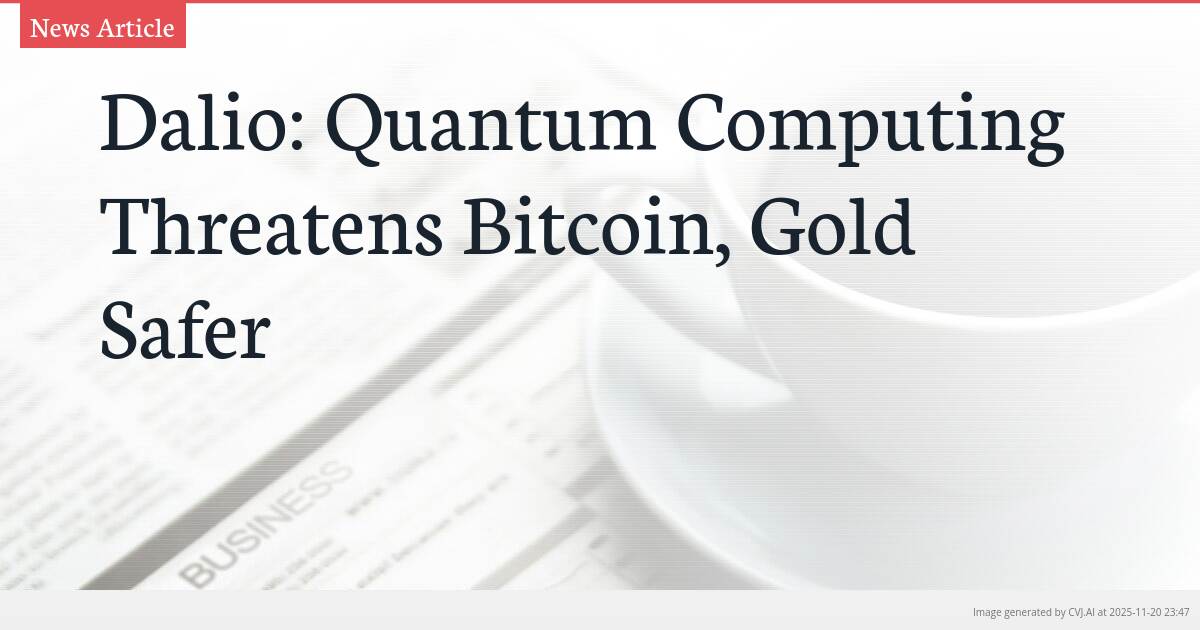Introduction
Bridgewater founder Ray Dalio has reiterated his preference for gold over Bitcoin, citing quantum computing vulnerabilities as a key concern for the cryptocurrency. The billionaire investor warned that Bitcoin’s reliance on technology makes it susceptible to future threats while gold remains independent. Dalio maintains both assets serve as hedges against currency debasement but sees gold as the superior long-term store of value.
Key Points
- Quantum computing advancements could potentially hack or control Bitcoin, undermining its security as a digital asset
- Gold's physical nature and independence from any system or third party makes it a more reliable long-term store of value
- Despite concerns, Dalio maintains both Bitcoin and gold serve as protection against currency debasement from rising government debts
The Quantum Computing Threat to Bitcoin's Foundation
Ray Dalio, the founder of Bridgewater Associates, has articulated a fundamental concern regarding Bitcoin’s long-term viability: its potential vulnerability to quantum computing. During a recent CNBC interview, Dalio stated, “I think the problem with Bitcoin is [that] it’s not going to be a reserve currency for major countries because it can be tracked, and it could be, conceivably, with quantum computing, controlled, hacked, and so on.” This warning highlights a technological frontier where advancements by companies like Google and IBM could eventually threaten the cryptographic security that underpins the entire Bitcoin network.
While Dalio acknowledged that it may be years before quantum computers are powerful enough to crack Bitcoin’s encryption, he emphasized the need to consider such future risks when evaluating an asset’s role as a store of value. This perspective places Bitcoin’s technological dependence in direct contrast with gold’s physical permanence. The concern is not merely theoretical; the industry is already seeing growing calls for precautionary measures to future-proof digital assets against this emerging computational power.
Gold's Independence Versus Bitcoin's Systemic Reliance
Dalio’s core argument centers on the fundamental difference in how these assets are held and secured. He noted that while “anyone with an internet connection can safeguard the digital asset on their own,” Bitcoin users remain “reliant on others, including a global network of machines to process transactions.” This systemic dependency creates potential points of failure that do not exist with physical gold. Dalio elaborated that gold is advantageous because “it can be physically held, without relying on anyone to provide anything,” making it a truly independent store of value.
This distinction becomes particularly relevant when considering Bitcoin’s transparency features. Dalio pointed out that Bitcoin transactions are recorded on a public ledger, making tracking straightforward once a digital wallet is linked to an identity. While services like coin mixers can obfuscate transaction flows, they add another layer of complexity and potential vulnerability. For Dalio, gold’s simplicity and physical nature provide a level of security and independence that digital assets cannot match, despite Bitcoin’s design for “an apocalyptic world.”
The Shared Role as Hedges Against Currency Debasement
Despite his preference for gold, Dalio recognizes that both assets serve as protection against what he sees as a growing global threat: currency debasement. He referenced his July comments urging investors to hedge against macroeconomic risks stemming from rising government debts in the U.S. and abroad. This year, gold’s price has jumped to record highs precisely on these fears, validating the metal’s traditional role as a safe haven during periods of fiscal uncertainty.
Dalio views both Bitcoin and gold as “hard currencies” because “their value can’t be debased by a government through money printing.” His debasement concerns are linked to rising levels of U.S. debt, but he noted that several countries, including the UK and France, are also facing mounting deficits that could lead to what he previously described as a “debt-fueled heart attack.” This shared characteristic explains why Dalio maintains exposure to both assets, even while favoring gold.
Institutional Adoption Amidst Persistent Concerns
Dalio’s cautious stance comes at a time of increasing institutional engagement with digital assets. Last week, the Czech National Bank unveiled its first investment in crypto, allocating $100 million across Bitcoin, stablecoins, and tokenized bank deposits. Officials described this as a “test portfolio” to help the central bank better understand how to handle digital assets, signaling a growing institutional curiosity that contrasts with Dalio’s reservations about Bitcoin’s suitability as a reserve currency for major nations.
The billionaire investor practices what he preaches regarding portfolio allocation. Dalio revealed that a “small percentage” of his portfolio has comprised Bitcoin for a long time, estimating it amounts to approximately 1% of his overall wealth. This modest allocation reflects his view that while Bitcoin has value as a hedge, it shouldn’t dominate a portfolio given its perceived vulnerabilities. In July, he had suggested investors allocate at least 15% of their holdings to Bitcoin and gold combined, indicating he sees both as complementary rather than mutually exclusive assets in a diversified strategy to protect against the systemic risks of currency debasement.
📎 Source reference: decrypt.co

